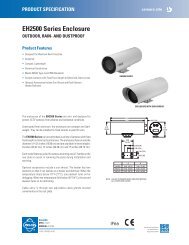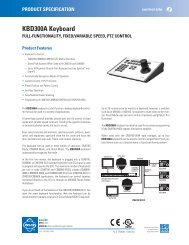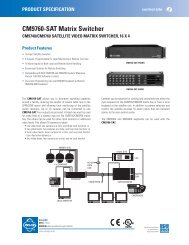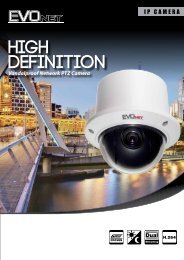Chapter 1 - Pacific Communications
Chapter 1 - Pacific Communications
Chapter 1 - Pacific Communications
Create successful ePaper yourself
Turn your PDF publications into a flip-book with our unique Google optimized e-Paper software.
User’s Manual<br />
• Recording service port (default: 11002): You need to do port forwarding for the recording service port to<br />
see recorded data in the NVR system.<br />
• Monitoring service port (default: 11004): You need to do port forwarding for the monitoring service port<br />
to receive event information from DVRs and IP products.<br />
DVRNS<br />
• Server Address, Server Port: Enter the IP address<br />
(domain name) and port number of the DVRNS server<br />
to register the NVR system.<br />
• Use DVRNS: Allows you to enter the name<br />
instead of the IP address of the NVR system by using<br />
the DVRNS function when connecting to the NVR<br />
system.<br />
− Use NAT: Check the box when the NVR system uses a NAT (Network Address Translation) device<br />
for network connection.<br />
− Name: Enter the NVR system name to be registered on the DVRNS server. Check whether or not<br />
the name is available by clicking the Check button.<br />
NOTES:<br />
• The DVRNS (DVR Name Service) function allows the NVR system to use dynamic IP addresses for remote<br />
connection. When using this function, you can access the NVR system remotely by using the NVR system<br />
name instead of its IP address. For the DVRNS function to work properly, the NVR system should be<br />
registered on the DVRNS server.<br />
• When LAN settings are changed, set up the DVRNS settings after saving your LAN changes by clicking<br />
the OK button.<br />
• You will need to get the IP address or domain name of the DVRNS server from your network administrator.<br />
You can use the domain name instead of IP address if you set up the DNS server during the IP Address<br />
setup.<br />
• When using a NAT (Network Address Translation) device, refer to the NAT manufacturer’s instructions<br />
for the proper network settings.<br />
• The NVR system name you entered in the Name field should be checked by clicking the Check button,<br />
otherwise the DVRNS changes will not be saved. When entering no name or a name already registered<br />
on the DVRNS server, an error message displays.<br />
SSL<br />
• Use SSL: Allows you to enhance the security of data<br />
transferred between services of the SiRiS program<br />
by using the SSL (Secure Sockets Layer) protocol.<br />
Using the SSL function might cause congestion in the<br />
NVR system depending on the security level. Log in<br />
the SiRiS program again after you change the setting.<br />
When the setting is changed, all services that are<br />
currently connected to the administration service<br />
reconnect, and the SiRiS Setup and SiRiS Client<br />
programs are logged out.<br />
12
















